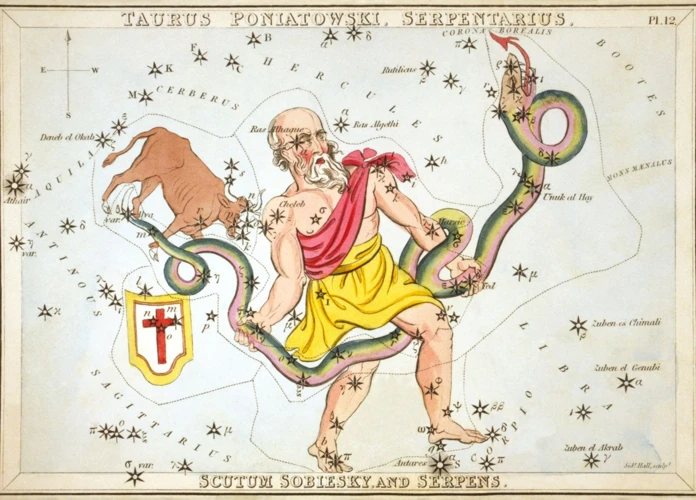The Ophiuchus symbol has long fascinated individuals interested in the realms of healing and medicine. This intriguing symbol holds a profound connection to ancient beliefs and practices, and its cultural significance spans across different societies. In this article, we will delve into the origin and history of the Ophiuchus symbol, explore its symbolic representation, and examine its association with the Ophiuchus constellation. Additionally, we will uncover the healing and medicinal connection associated with this symbol, ranging from ancient beliefs to modern interpretations. Join us on this journey as we unravel the symbolic elements and their meanings, uncover historical and modern applications, and address the controversies and misconceptions surrounding the enigmatic Ophiuchus symbol.
Contents
- Exploring the Ophiuchus Symbol
- The Healing and Medicinal Connection
- Symbolic Elements and Their Meanings
- Historical and Modern Applications
- Controversies and Misconceptions
- Conclusion
-
Frequently Asked Questions
- 1. What is the meaning behind the Ophiuchus symbol?
- 2. Why is the Ophiuchus symbol associated with snakes?
- 3. How does the Ophiuchus symbol relate to ancient Egyptian mythology?
- 4. What role does the Ophiuchus symbol play in Hindu mythology?
- 5. Why is the Ophiuchus symbol omitted from the traditional zodiac?
- 6. Is there any scientific basis for the healing properties associated with the Ophiuchus symbol?
- 7. How is the Ophiuchus symbol represented in astrology?
- 8. What is the difference between the Ophiuchus symbol and the caduceus symbol used in medicine?
- 9. Are there any controversies surrounding the recognition of Ophiuchus as a zodiac sign?
- 10. How does the Ophiuchus symbol continue to influence modern medicine?
- References
-
Frequently Asked Questions
- 1. What is the significance of the Ophiuchus symbol in medicine?
- 2. How does the Ophiuchus symbol relate to ancient healing practices?
- 3. Can the Ophiuchus symbol be used as a modern healing tool?
- 4. What is the connection between astrology and health in relation to Ophiuchus?
- 5. What does the serpent symbolism represent in the Ophiuchus symbol?
- 6. How does the Rod of Asclepius relate to Ophiuchus?
- 7. How is the Ophiuchus symbol connected to the medical caduceus?
- 8. Is Ophiuchus considered a controversial 13th zodiac sign?
- 9. Does mainstream medicine recognize the significance of Ophiuchus?
- 10. How can I incorporate the Ophiuchus symbol into my healing practices?
- References
- Read More
Exploring the Ophiuchus Symbol
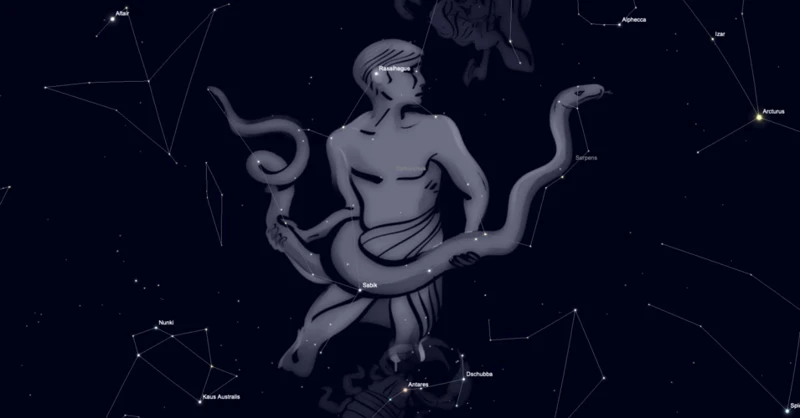
The Ophiuchus symbol is a captivating figure that has captivated the interest of many throughout history. It holds a rich historical and cultural significance, often associated with healing and medicine. Let’s dive into the various aspects of this symbol that make it so intriguing.
The origins of the Ophiuchus symbol can be traced back to ancient Greek mythology. Ophiuchus, also known as Asclepius, was a skilled healer and physician. His symbol, depicting a serpent entwined around a rod, represented the healing power associated with snakes. The symbol has been linked to Asclepius’ ability to revive the dead, making it a powerful representation of healing and resurrection in ancient times. Over the centuries, variations of the Ophiuchus symbol emerged in different cultures, each attaching their own unique meanings to it.
The Ophiuchus symbol, with its serpent and rod composition, carries a multitude of symbolic representations. The serpent has long been associated with healing due to its ability to shed its skin and rejuvenate itself. This shedding process symbolizes personal growth, transformation, and healing. The rod, often referred to as the Rod of Asclepius, serves as a powerful metaphor for medical intervention and expertise. It represents the staff carried by Asclepius himself and is seen as a symbol of wisdom, authority, and healing power.
Throughout history, the Ophiuchus symbol has held cultural significance in a variety of societies. In ancient Egypt, the symbol was linked to Imhotep, the god of medicine and healing. In Hindu mythology, it was connected to Lord Dhanvantari, the physician of the gods. Native American cultures also incorporated snakes in their healing practices, recognizing their transformative qualities. The symbol’s prevalence across different cultures highlights its universal association with healing and medicine.
The Ophiuchus symbol finds its celestial counterpart in the Ophiuchus constellation. This constellation lies along the ecliptic, the path followed by the Sun across the sky. Despite being omitted from the traditional zodiac, the Ophiuchus constellation was recognized by early astronomers for its prominence in the night sky. Its position near the Serpent constellation further solidifies the connection to healing, as the serpent is intertwined with the figure of Ophiuchus in the night sky.
By exploring the origins, symbolic representation, cultural significance, and astronomical aspects of the Ophiuchus symbol, we gain a deeper understanding of its connection to healing and medicine. This exploration sets the stage for further examination of the healing and medicinal aspects associated with this intriguing symbol.
1. Origin and History
The origin and history of the Ophiuchus symbol can be traced back to ancient Greek mythology, specifically to the figure of Asclepius. Asclepius, also known as Aesculapius, was a highly revered physician and healer in Greek mythology. According to the myth, Asclepius possessed remarkable healing powers and was even capable of resurrecting the dead.
The symbol associated with Asclepius, the Ophiuchus symbol, is depicted as a serpent wrapped around a rod. This symbolizes the healing power of snakes, as they were believed to possess regenerative abilities. The shedding of a snake’s skin represented renewal and transformation, reinforcing the connection between serpents and healing.
Asclepius was the son of Apollo, the Greek god of healing, prophecy, and music. He learned the art of healing from the centaur Chiron, who taught him the secrets of medicine and surgery. However, Asclepius’s abilities surpassed those of his mentor, and he became renowned for his miraculous healings.
The Ophiuchus symbol represents not only Asclepius but also embodies his attributes and achievements. Often referred to as the Rod of Asclepius, the symbol is recognized as a potent emblem of healing, wisdom, and authority in the medical field.
Over time, the influence of Asclepius and the Ophiuchus symbol spread beyond ancient Greece. It became an essential part of the healing practices in the Roman Empire, and Asclepius was worshipped as a god in various regions.
In addition to its prominence in ancient Greek and Roman cultures, the Ophiuchus symbol found its way into Egyptian mythology and other ancient belief systems. The symbol was associated with Imhotep, the Egyptian god of medicine and healing. Imhotep’s healing abilities were so revered that he was eventually deified and worshipped as a god.
As the symbol evolved through different cultures and time periods, it became a recognizable representation of healing and medicine across various civilizations. The enduring legacy of the Ophiuchus symbol highlights its significance in human history, as it continues to fascinate and inspire individuals interested in the healing arts.
To learn more about the impact of the Ophiuchus zodiac symbol in popular culture, you can explore our article on the impact of Ophiuchus zodiac memes.
2. Symbolic Representation
The Ophiuchus symbol holds deep symbolic representation that can be interpreted in various ways. Its composition, consisting of a serpent entwined around a rod, carries profound meaning associated with healing and medicine.
The serpent, a key element in the Ophiuchus symbol, has been a powerful symbol since ancient times. It represents transformation, rebirth, and healing due to its ability to shed its skin and emerge anew. This shedding process is seen as a metaphor for personal growth and the power to heal and rejuvenate. The serpent’s association with regeneration and transformation has made it a central figure in healing practices across different cultures and traditions.
The rod, commonly referred to as the Rod of Asclepius, is another important component of the Ophiuchus symbol. It holds a long-standing association with medicine and healing. The rod is often depicted with a single serpent entwined around it, distinguishing it from the caduceus symbol, which features two serpents and wings. The Rod of Asclepius signifies wisdom, authority, and the healing power bestowed upon healers and physicians. It embodies the idea of seeking knowledge and using it for the betterment of others.
Together, the serpent and the rod in the Ophiuchus symbol create a powerful visual representation of healing and medicine. The serpent’s transformative qualities and the rod’s association with wisdom and authority combine to represent the profound impact that healers and medical practitioners have on the well-being of individuals. This symbolism is both a reminder of the potential for growth and transformation in healing journeys and a recognition of the importance of knowledge and expertise in the field of medicine.
To fully understand the significance of the Ophiuchus symbol and its symbolic representation, we must explore its historical and cultural context, as well as its connections to astrology and alternative medicine. This exploration will provide further insight into the fundamental role the symbol plays in the healing and medicinal realm.
3. Cultural Significance
The cultural significance of the Ophiuchus symbol extends across various societies throughout history. In ancient Egypt, the symbol was closely linked to Imhotep, a revered god associated with healing and medicine. Imhotep was considered the patron deity of physicians and was revered as a great healer. The Ophiuchus symbol’s connection to Imhotep reinforces its association with the healing arts in Egyptian culture.
In Hindu mythology, the serpent symbolism of the Ophiuchus symbol is connected to Lord Dhanvantari, the divine physician and an incarnation of Lord Vishnu. Lord Dhanvantari is believed to have brought the knowledge of Ayurveda, the ancient Indian system of medicine, to humanity. The Ophiuchus symbol’s association with Lord Dhanvantari highlights its significance as a symbol of healing and wellness in Hindu culture.
Native American cultures also hold the serpent as a sacred and powerful animal associated with healing. The Ophiuchus symbol’s serpent and rod composition aligns with the Native American belief in snake medicine, where snakes represented transformation and healing. Snake rituals and ceremonies were performed to invoke healing energies and facilitate physical, emotional, and spiritual well-being. The Ophiuchus symbol’s recognition in Native American cultures further exemplifies its cultural significance in relation to healing practices.
The Ophiuchus symbol’s prevalence in various cultures showcases its universal appeal and recognition as a symbol of healing and medicine. Despite originating from different corners of the world, these cultures share a common reverence for the serpent and its transformative qualities. The Ophiuchus symbol serves as a unifying emblem that transcends cultural boundaries and represents the timeless pursuit of healing, wellness, and the restoration of harmony within oneself and the world.
4. The Ophiuchus Constellation
The Ophiuchus constellation is a fascinating astronomical formation that holds significance in astronomy and astrology. Its name derives from the Greek word for “serpent-bearer,” representing the figure of Ophiuchus in the night sky. This constellation is situated along the celestial equator and is often associated with healing and medicine. Despite not being recognized as one of the traditional zodiac constellations, the Ophiuchus constellation has a distinct presence in the astral realm.
The Ophiuchus constellation is located between the constellations of Serpens and Hercules. It is best visible during the summer months in the northern hemisphere. Ophiuchus is depicted as a man holding a serpent, symbolizing the figure of Asclepius in Greek mythology. According to ancient tales, Asclepius was a skilled healer who possessed the power to resurrect the dead.
The prominent star in the Ophiuchus constellation is Rasalhague, which marks the head of the serpent held by Ophiuchus. Rasalhague is a binary star system, meaning it consists of two stars in close proximity to each other. This binary system shines brightly in the night sky and is easily distinguishable.
The Ophiuchus constellation has captured the imagination of astronomers and astrologers alike. Although it is not officially recognized as a zodiac sign, there has been speculation about its possible inclusion in astrology. Some astrologers argue that those born between November 29 and December 17 fall under the influence of Ophiuchus, suggesting a potential shift in the zodiac system.
From an astronomical perspective, the Ophiuchus constellation has contributed to our understanding of the universe. Exploration beyond our solar system, including the search for exoplanets, has involved studying celestial bodies within and near the Ophiuchus constellation. Scientists continue to unravel the mysteries hidden within this fascinating constellation, deepening our knowledge of the cosmos.
The Ophiuchus constellation is a captivating formation in the night sky. It carries symbolic significance, representing the figure of Asclepius and embodying healing and medicine. While not recognized as part of the traditional zodiac, its presence and influence continue to be explored in both astronomical and astrological contexts. The Ophiuchus constellation beckons us to gaze upwards and ponder the interconnectedness of the celestial and earthly realms.
The Healing and Medicinal Connection
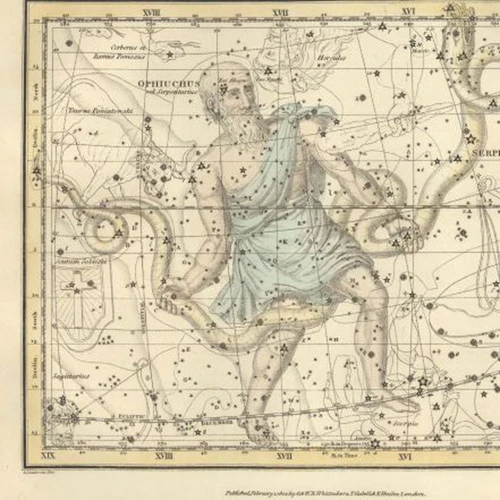
The Ophiuchus symbol’s connection to healing and medicine extends across ancient beliefs and practices, as well as modern interpretations. Ancient civilizations, such as the Greeks and Egyptians, revered the healing abilities associated with the symbol. In Greek mythology, Asclepius, represented by the Ophiuchus symbol, was revered as the god of healing and medicine. Temples dedicated to Asclepius were centers for healing where individuals sought divine intervention for their ailments. These temples hosted various healing rituals, including sleeping in the temple’s sacred space, where it was believed that Asclepius would appear in dreams to provide guidance and healing. The serpent, an integral part of the Ophiuchus symbol, was also associated with healing in ancient beliefs. Its ability to shed its skin represented regeneration and renewal, qualities attributed to healing and transformative processes.
In modern times, the Ophiuchus symbol continues to be associated with healing and is embraced by many alternative healing practices. The symbol serves as a powerful reminder of the innate healing potential within individuals. The concept of healing encompasses physical, emotional, and spiritual well-being, and Ophiuchus symbolizes the balance and restoration of these aspects. Alternative medicine practices, such as energy healing and crystal therapy, incorporate the Ophiuchus symbol as a way to channel and harness healing energies.
Astrology also plays a role in the healing and medicinal connection of the Ophiuchus symbol. Astrologers believe that individuals born under the Ophiuchus sign possess unique healing abilities and empathetic qualities. They are seen as natural healers and have a strong affinity for nurturing and supporting others. The Ophiuchus symbol is believed to enhance these healing attributes, making individuals born under this sign particularly attuned to the healing arts.
The healing and medicinal connection of the Ophiuchus symbol extends beyond individual healing practices. It also encompasses a broader perspective of healing on a global scale. Many practitioners and enthusiasts of alternative medicine view the symbol as a representation of the Earth’s healing energy and the restoration of harmony and balance within the planet and its ecosystems. This holistic approach emphasizes the interconnectedness of all living beings and the importance of healing on multiple levels, from personal to planetary.
By exploring the ancient beliefs and practices, modern interpretations, and astrological aspects associated with the Ophiuchus symbol, we gain insight into its profound connection to healing and medicine. The next sections will delve deeper into the symbolic elements and their meanings, as well as historical and modern applications of the Ophiuchus symbol in the field of medicine.
1. Ancient Beliefs and Practices
Ancient beliefs and practices surrounding the Ophiuchus symbol provide fascinating insights into the healing and medicinal traditions of the past. Across various ancient civilizations, the serpent-entwined figure of Ophiuchus was revered as a powerful healer and guardian of health. In ancient Greece, the birthplace of modern medicine, the symbol was associated with Asclepius, the god of medicine. Asclepius was worshipped in sanctuaries called Asclepieia, where individuals sought healing through sacred rituals and therapeutic practices. These practices included dream interpretation, spiritual purification, and the use of herbs and potions to treat ailments. The healing powers of Asclepius were often channeled through symbolically powerful objects, such as the staff with a serpent entwined around it. This staff, now known as the Rod of Asclepius, has become a widely recognized symbol of medicine and is still used today.
In addition to Greece, ancient Egypt also had a rich tradition of healing and revered the serpent as a sacred symbol. The Egyptian god Imhotep, considered the patron of medicine and healing, was often depicted with serpents wrapped around his staff. Egyptians believed in the power of amulets and charms adorned with serpent motifs to protect against illness and ensure good health. The serpent’s ability to shed its skin was seen as a symbol of rejuvenation and vitality, making it closely associated with healing and regeneration.
Similarly, the ancient Aztecs regarded snakes as symbols of healing and transformation. They believed that serpents possessed divine healing wisdom, and their priests often used snake venom in medicinal remedies. The Aztecs also incorporated serpent imagery into their religious rituals and temples. The connection between the serpent and healing was so deeply ingrained in their culture that the Aztec word for “doctor” was “coatl-exohki,” which translates to “snake-doctor.”
Across these ancient beliefs and practices, the Ophiuchus symbol and its association with serpents held immense importance in healing and medicine. The serpent’s ability to shed its skin and transform symbolized the rejuvenation and healing process. The figure of Ophiuchus, whether in the form of Asclepius, Imhotep, or other deities, represented divine healing wisdom and was revered as a protector and guide in the realm of health. These ancient beliefs and practices laid the foundation for the modern understanding of the healing and medicinal connection with the Ophiuchus symbol.
2. Modern Interpretations
Modern interpretations of the Ophiuchus symbol have expanded upon its historical and mystical origins, further solidifying its connection to healing and medicine in contemporary contexts.
1. Astrological Relevance: In recent years, the Ophiuchus symbol has sparked debate within the astrology community. Some astrologers argue that the Ophiuchus constellation should be considered as the thirteenth zodiac sign, alongside the traditional twelve. According to this line of thinking, individuals born between November 29 and December 17 fall under the influence of Ophiuchus. Believers in this interpretation perceive Ophiuchus as a powerful healer and spiritual guide, attributing traits such as intuition, wisdom, and transformative healing abilities to those born under this sign.
2. Energy Healing: The symbolic elements of the Ophiuchus symbol have also found resonance in the realm of energy healing. Practitioners of energy healing modalities, such as Reiki or crystal therapy, associate the serpent symbolism with the Kundalini energy that resides within each person. The Kundalini energy is said to represent spiritual awakening and the flow of life force energy throughout the body. The Ophiuchus symbol, with its representation of a serpent, serves as a visual reminder of this powerful energy and its potential for healing and transformation.
3. Symbolic Tattoos: The Ophiuchus symbol has gained popularity as a tattoo design, particularly among individuals who resonate with its healing representations. People who choose to have this symbol permanently inked on their bodies often do so as a reminder of their own healing journey, personal growth, overcoming adversity, or to honor their connection to the medical profession. The Ophiuchus tattoo serves as a visual affirmation of the individual’s commitment to healing, resilience, and their willingness to embrace transformation.
4. New Age Spirituality: Within the realm of New Age spirituality, the Ophiuchus symbol is often associated with spiritual awakening, heightened consciousness, and the path of the healer. It is seen as a representation of the integration of both light and shadow aspects of the self, acknowledging the inherent balance required for healing and transformation. New Age practitioners and enthusiasts may incorporate the Ophiuchus symbol into their practices, rituals, or meditations as a focal point for intentions related to healing, self-discovery, and personal growth.
As modern interpretations of the Ophiuchus symbol continue to evolve, its link to healing and medicine remains at the forefront. Whether through its astrological relevance, association with energy healing, adoption as tattoo art, or incorporation into new age practices, the Ophiuchus symbol continues to inspire and empower individuals on their paths of healing and self-discovery. It serves as a visual reminder of the transformative power that lies within each of us, inviting us to embrace our innate capacity for healing and the potential for growth and renewal.
3. Astrology and Health
Astrology has long been intertwined with beliefs about health and well-being. Many individuals turn to astrology as a means of gaining insight into their physical and mental well-being. While astrology is not considered a scientifically validated approach to medicine, it continues to provide a unique perspective on health from a holistic standpoint.
In astrology, each zodiac sign is associated with specific characteristics and traits, including potential health strengths and vulnerabilities. The inclusion of Ophiuchus as a 13th zodiac sign offers a new dimension to astrological interpretations of health. Ophiuchus individuals are believed to possess highly intuitive and healing qualities, often drawn to professions in healthcare or alternative medicine.
Astrologers who incorporate Ophiuchus into their practice suggest that those born under this sign may have a natural inclination towards alternative forms of healing. This includes practices such as herbal medicine, energy healing, or mind-body therapies. Ophiuchus is often associated with the serpent symbolism, which represents transformation and healing energy, further enhancing the connection to alternative healing modalities.
While astrology may not have a direct impact on physical health, it can provide individuals with a different lens through which to view their overall well-being. Some individuals find comfort and guidance in aligning their lifestyle choices, dietary habits, and self-care routines with the insights provided by astrology. It can serve as a tool for self-reflection and personal growth, supporting individuals in taking a holistic approach to their health.
It’s important to note that astrology should not replace medical advice or professional healthcare. Rather, it can complement one’s understanding of themselves and their unique strengths and vulnerabilities. Consulting with healthcare professionals, seeking evidence-based treatments, and maintaining a healthy lifestyle are essential for optimal health.
As we explore the connection between astrology and health, it becomes clear that while astrology offers intriguing insights, it should be approached with an open mind and a critical perspective. Incorporating astrology into one’s health journey can be a personal choice, allowing individuals to explore different aspects of their well-being in a holistic manner. While its scientific validity may be questioned, astrology continues to play a role in providing individuals with a framework to navigate their physical, emotional, and spiritual health.
Symbolic Elements and Their Meanings
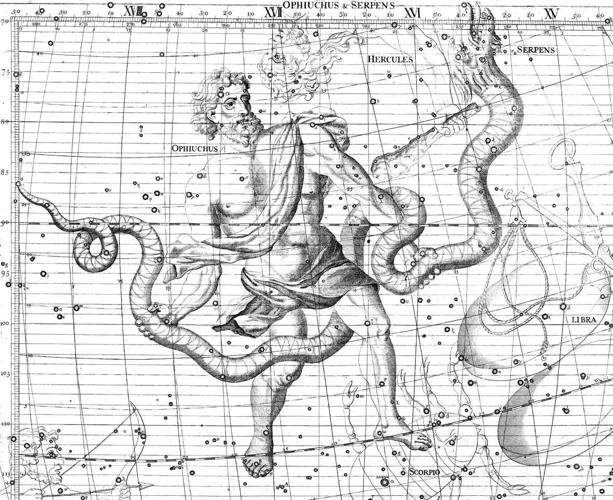
The Ophiuchus symbol is comprised of several elements, each carrying its own symbolic meaning. Understanding these elements provides insight into the deeper significance of the symbol.
The serpent symbolism within the Ophiuchus symbol holds a multitude of interpretations across different cultures. In ancient beliefs, serpents were associated with healing, transformation, and divine wisdom. They were revered as creatures capable of shedding their skin, representing rebirth, renewal, and regeneration. The serpent’s ability to slither and move through tight spaces also symbolizes adaptability and flexibility. In the context of the Ophiuchus symbol, the serpent represents the transformative power of healing.
Another key element of the symbol is the Rod of Asclepius. This rod, depicted as a single staff with a serpent wrapped around it, holds deep significance in the field of medicine. It is often mistakenly confused with the medical caduceus, which features two serpents and wings. While the caduceus is associated with Hermes, the messenger of the gods, the Rod of Asclepius specifically represents healing and medicine. It serves as a symbol of authority, knowledge, and the power of medical intervention.
The combination of the serpent and the rod in the Ophiuchus symbol unifies the themes of healing, regeneration, and medical expertise. The serpent intertwining itself around the rod symbolizes the connection between ancient wisdom and the practice of medicine. It exemplifies the integration of knowledge and the power to heal, creating a harmonious balance between the physical and spiritual aspects of healing.
The symbolic elements of the Ophiuchus symbol, the serpent, and the Rod of Asclepius, encapsulate the essence of healing and medicine. Their representations of transformation, regeneration, and medical expertise make them powerful symbols within the realm of healing practices. By understanding the meanings behind these elements, we can better appreciate the profound significance that the Ophiuchus symbol holds in the context of healing and medicine’s ancient traditions.
1. Serpent Symbolism
Serpent symbolism plays a significant role in understanding the deeper meaning behind the Ophiuchus symbol. Throughout history and across various cultures, serpents have been revered for their transformative qualities, shedding their skin to symbolize rejuvenation and healing. In the context of the Ophiuchus symbol, the serpent represents not only physical healing but also spiritual and emotional transformation. The serpent’s ability to rejuvenate itself symbolizes the cyclical nature of life, the process of growth, and the pursuit of knowledge and wisdom. In ancient Greek mythology, the serpent entwined around the staff of Asclepius, as depicted in the Ophiuchus symbol, represented the healing power associated with snakes. This association persists in various healing traditions around the world. For example, in Ayurvedic medicine, the serpent symbolizes the dormant spiritual energy coiled at the base of the spine, known as Kundalini, which, when awakened, leads to enlightenment and holistic healing. The serpent symbolism within the Ophiuchus symbol provides a profound representation of the transformative power of healing, inviting us to embrace change, let go of what no longer serves us, and embark on a journey of self-discovery and growth.
2. Rod of Asclepius
The Rod of Asclepius is a powerful symbol that holds great significance in the field of healing and medicine. This ancient symbol consists of a single serpent wrapped around a staff, and it has been associated with the Greek god of healing, Asclepius.
The serpent, a key element of the symbol, is often seen as a representation of rebirth, transformation, and healing. In Greek mythology, Asclepius was said to possess the ability to heal the sick and even bring the dead back to life. The serpent symbolizes rejuvenation, as it sheds its skin and emerges anew. This shedding process is associated with renewal, growth, and the healing of ailments.
The staff, the other important component of the symbol, represents authority, wisdom, and healing power. The Rod of Asclepius is often depicted as a simple wooden walking stick entwined by a single serpent, highlighting the connection between the healing power of snakes and the knowledge and expertise of healers.
Throughout history, the Rod of Asclepius has been widely recognized as a symbol of medicine and healthcare. It is commonly used by medical organizations, hospitals, and pharmaceutical companies as a representation of healing and healthcare services. This symbol is distinct from the medical caduceus, which portrays two serpents wrapped around a staff with wings at the top. While the caduceus is often mistakenly associated with the medical field, the Rod of Asclepius is the more accurate and appropriate symbol.
Interestingly, the Rod of Asclepius holds significance not just in the field of medicine, but also in astrology. In astrology, the symbol of the serpent and staff is associated with the sun sign of Aries and its connection to healing and vitality. This further reinforces the symbol’s relationship with healing practices and the promotion of well-being.
The Rod of Asclepius plays a vital role in symbolizing the healing arts. It represents the power of rejuvenation, wisdom, and expertise in the field of medicine. With its rich historical and cultural heritage, this ancient symbol continues to inspire and remind us of the noble and vital work carried out by healers and medical professionals worldwide.
Historical and Modern Applications
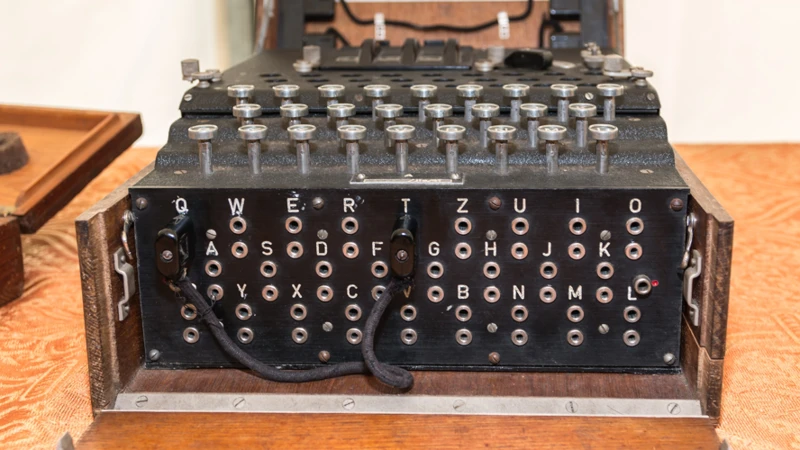
The Ophiuchus symbol has made its way into various historical and modern applications, shedding light on its significance in the field of healing and medicine. One notable connection between the Ophiuchus symbol and the medical field lies in the use of the Ophiuchus constellation in the medical caduceus. The caduceus, a winged staff entwined by two serpents, is often mistakenly associated with medicine. However, its origin can be traced back to Greek mythology where it was the staff of the messenger god Hermes.
The association between the Ophiuchus constellation and the caduceus is intriguing, as it merges the healing and messenger aspects. The serpent symbolism in both the Ophiuchus symbol and the caduceus represents healing and rejuvenation. The staff, on the other hand, signifies authority and wisdom, qualities essential in the medical field. Despite the historical confusion in using the caduceus as a medical symbol, it continues to be utilized in modern healthcare settings.
Beyond its connection to the medical caduceus, the Ophiuchus symbol has also found its place in traditional healing practices. In ancient cultures, such as the Greeks, Egyptians, and Native Americans, snakes were believed to possess healing powers. Their ability to shed their skin and renew themselves symbolized rejuvenation and healing. Snakes were often kept in temples and used in rituals as part of healing ceremonies. Even today, some alternative medicine practitioners incorporate snake venom or snake-related therapies into their treatments.
In the realm of alternative medicine, the Ophiuchus symbol holds particular significance. It represents a holistic approach to healing, focusing on mind, body, and spirit. Practitioners who align with the symbol’s energy believe in harnessing the power of the serpent’s transformation and the healing properties associated with it. This may involve practices such as energy healing, herbal remedies, or other non-traditional modalities.
While the use of the Ophiuchus symbol in mainstream medicine is limited, its influence can still be seen in various historical and modern applications. From the inclusion of the Ophiuchus constellation in the medical caduceus to its presence in traditional healing practices and alternative medicine, the symbol continues to inspire and intrigue those seeking healing and wellness. Its rich historical significance and modern applications shed light on the enduring connection between the Ophiuchus symbol and the world of medicine.
1. Medical Caduceus and Ophiuchus
The medical Caduceus symbol, often associated with healthcare and the medical profession, has similarities to the Ophiuchus symbol. Despite their visual similarities, it’s important to note that the Caduceus symbol and the Ophiuchus symbol represent distinct concepts.
1. The Caduceus symbol consists of two intertwining snakes wrapped around a winged staff. It is commonly associated with Hermes, the messenger of the gods in Greek mythology. The Caduceus symbol has become widely recognized as a representation of the medical profession in modern times, often seen on medical documents, signs, and uniforms. However, the association between the Caduceus symbol and medicine is not rooted in ancient medical practices, but rather due to a historical misconception.
The Caduceus symbol was originally associated with commerce, negotiation, and heraldry, rather than medicine. Its connection to Hermes, the messenger of the gods, symbolized the role of communication and trade. The wings on the Caduceus symbol exemplify the fast and efficient exchange of messages. However, due to a misinterpretation in the early 19th century, the Caduceus symbol became mistakenly linked to medicine.
2. On the other hand, the Ophiuchus symbol represents the serpent-bearer, associated with healing and medicine. While the Caduceus symbol features two snakes, the aspect of healing primarily lies with the Ophiuchus symbol. The Ophiuchus serpent is depicted entwined around a rod or staff, similar to the Caduceus. However, the Ophiuchus symbol has a deeper historical association with healing, encompassing ancient beliefs, cultural significance, and the Ophiuchus constellation.
It’s worth mentioning that the Caduceus symbol and the Ophiuchus symbol are often confused due to their visual similarities. However, the Caduceus is more commonly used in commercial and organizational contexts, while the Ophiuchus symbol holds a stronger connection to healing and medicine.
The medical Caduceus symbol and the Ophiuchus symbol share visual resemblances, but they represent different ideas. The Caduceus symbol is associated with commerce and communication, while the Ophiuchus symbol is linked to healing and medicine. Understanding the distinction between these symbols is important to appreciate their respective historical and symbolic significance.
2. Traditional Healing Practices
Traditional healing practices have long recognized the significance of the Ophiuchus symbol in their methodologies. Across various cultures and ancient civilizations, the symbol has been associated with healing rituals, herbal medicine, and spiritual practices.
In ancient Greek civilization, the Ophiuchus symbol was primarily linked to the healing god Asclepius. Temples dedicated to Asclepius were known as Asclepieia, and they served as centers for spiritual and physical healing. Asclepieia offered a holistic approach to wellness, combining various elements such as prayer, dream analysis, hydrotherapy, and herbal remedies. The Ophiuchus symbol, prominently displayed within these temples, served as a focal point for healing energies.
Native American tribes also incorporated the Ophiuchus symbol into their traditional healing practices. The serpent, a crucial element of the symbol, was considered a powerful spirit guide in these cultures. Native healers would often perform snake dances or handle live snakes as part of their healing rituals. The shedding of a snake’s skin was seen as a metaphor for the healing process, symbolizing the renewal of the body, mind, and spirit.
Traditional Chinese medicine (TCM), which follows a holistic approach to healing, recognizes the significance of the Ophiuchus symbol. In TCM, snakes are associated with the meridians, which are energy pathways in the body. The snake’s ability to shed its skin represents the process of rejuvenation and rebirth. Snake-based remedies, such as snake venom and snake wine, have been used in TCM for their alleged healing properties.
Ancient healing practices from various cultures demonstrate their belief in the healing powers represented by the Ophiuchus symbol. These practices recognized the importance of spiritual and physical well-being, incorporating the symbolism of the serpent and the rod into their healing rituals. While modern medicine has evolved, traditional healing practices continue to be valued and respected, preserving the wisdom passed down through generations.
As we delve deeper into the healing and medicinal association with the Ophiuchus symbol, we will explore modern interpretations and the role of astrology in health. Stay tuned for the upcoming sections as we uncover the fascinating connections between the Ophiuchus symbol and the healing arts.
3. Ophiuchus in Alternative Medicine
Ophiuchus has also made its way into the realm of alternative medicine, where it is sometimes seen as a symbol of healing and holistic practices. In this context, Ophiuchus represents the integration of traditional medicine with alternative healing modalities. Alternative medicine approaches recognize the interconnectedness of the mind, body, and spirit in the healing process, and the Ophiuchus symbol aligns with this holistic perspective.
Practitioners of alternative medicine may incorporate the Ophiuchus symbol into their healing spaces as a reminder of the importance of balance and harmony in health. It acts as a visual representation of the integration of different healing practices, such as acupuncture, herbal medicine, energy healing, and mindfulness techniques. The symbol reflects the belief that healing encompasses more than just the physical body, but also includes emotional, mental, and spiritual well-being.
In some alternative healing modalities, the serpent aspect of the Ophiuchus symbol is seen as a metaphor for the kundalini energy, which is believed to reside at the base of the spine. Kundalini energy is said to represent a dormant spiritual energy that can be awakened and channeled through various practices, leading to enhanced well-being and spiritual growth.
The Ophiuchus symbol’s association with alternative medicine demonstrates the evolving nature of healing practices and the recognition of the importance of a holistic approach to health. It represents a shift towards integrating traditional medicine with complementary practices that aim to support the body’s natural healing processes and promote overall wellness.
While alternative medicine embraces the Ophiuchus symbol as a representation of holistic healing, it is important to note that the scientific community does not recognize astrology or the symbolism associated with Ophiuchus as having any evidence-based medical effects. Alternative medicine should always be approached with caution, and it is advisable to consult with qualified healthcare professionals before incorporating any alternative healing practices into one’s treatment plan.
In the next section, we will delve into the controversies and misconceptions surrounding the Ophiuchus symbol, including the debate about the 13th zodiac sign and its reception in mainstream medicine. Stay tuned to learn more about the debates and varying perspectives associated with this enigmatic symbol.
Controversies and Misconceptions
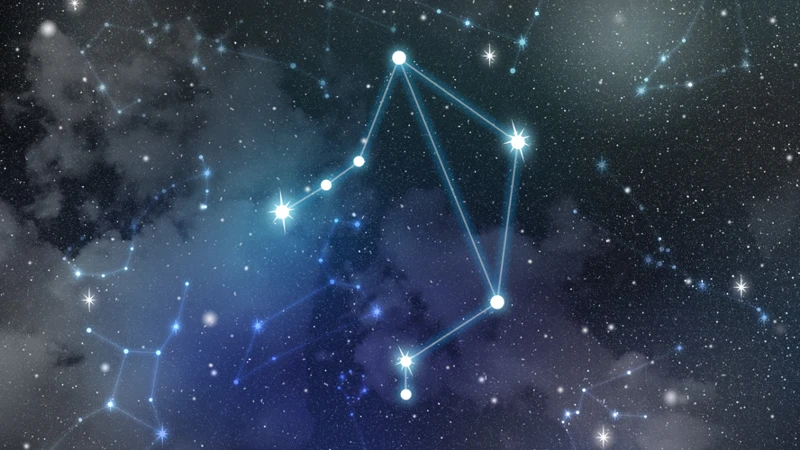
Controversies and misconceptions surrounding the Ophiuchus symbol have emerged over time, fueling debates and challenging traditional beliefs. One of the most prominent debates revolves around the addition of Ophiuchus as the 13th zodiac sign. This controversy stems from the idea that the Earth’s axis has gradually shifted since the ancient astrological system was established, leading to a discrepancy in the alignment of the zodiac constellations. Some argue that the inclusion of Ophiuchus would disrupt the widely accepted zodiac dates and shift the astrological chart as a whole. However, it’s important to note that the zodiac signs are not based on constellations but rather on the Sun’s apparent path through the sky. Thus, the inclusion of Ophiuchus does not necessarily invalidate the existing zodiac system.
Another prevalent misconception about Ophiuchus lies in its association with mainstream medicine. Although the symbol holds a strong link to healing and medicine in ancient traditions, it is not widely acknowledged or utilized in modern medical practices. The medical community primarily relies on the Rod of Asclepius, which features a single serpent entwined around a rod, as the symbol of medicine. The use of the caduceus, a symbol with two serpents and wings, in modern medical iconography has contributed to the confusion surrounding Ophiuchus. While the caduceus is often mistakenly associated with healing, it has its origins in Greek mythology as a symbol of commerce and negotiation, not medicine. Despite the misconceptions and controversies surrounding Ophiuchus, its significance in alternative healing practices and its rich symbolism continue to captivate the imagination of those interested in the intersection of healing, astrology, and mythology.
1. The 13th Zodiac Sign Debate
The debate surrounding the inclusion of a 13th zodiac sign, Ophiuchus, has sparked controversy and confusion among astrology enthusiasts. Ophiuchus, represented by the serpent bearer, challenges the traditional notion of the zodiac that consists of 12 signs. This debate stems from the precession of the Earth’s axis, causing a shift in the alignment of the constellations over time.
Proponents of including Ophiuchus argue that the zodiac should reflect the actual positions of the constellations in the sky. They believe that Ophiuchus should be recognized as the 13th zodiac sign, positioned after Scorpio and before Sagittarius. Those who support this viewpoint claim that individuals born between November 29 and December 17 should identify as Ophiuchus.
On the other hand, skeptics argue that the zodiac signs are symbolic representations rather than direct reflections of the constellations. They assert that the traditional 12 signs hold historical and astrological significance and should not be altered. This viewpoint emphasizes the symbolic interpretations of the zodiac signs rather than their astronomical alignment.
The controversy surrounding the 13th zodiac sign has caused confusion among astrology enthusiasts and led to debates over the interpretation of birth charts and horoscopes. Some astrologers have embraced the inclusion of Ophiuchus, offering insights into its characteristics and compatibility with other signs. However, many astrologers and astrology enthusiasts continue to adhere to the traditional 12-sign zodiac system, disregarding Ophiuchus.
It is important to note that the inclusion of Ophiuchus as a zodiac sign is not universally accepted or recognized by all astrologers. The debate surrounding Ophiuchus serves as a reminder of the complexities and diverse interpretations within the field of astrology.
The debate over the inclusion of Ophiuchus as the 13th zodiac sign remains a topic of discussion among astrology enthusiasts. While some argue for its recognition based on the alignment of the constellations, others emphasize the symbolic interpretations of the zodiac signs. Whether Ophiuchus will be incorporated into mainstream astrology or remain a point of contention is yet to be determined.
2. Ophiuchus in Mainstream Medicine
In mainstream medicine, the presence of Ophiuchus as a symbol is not commonly observed. The traditional medical symbol is the Caduceus, which consists of a rod entwined by two serpents with wings at the top. This symbol is often mistakenly associated with Ophiuchus, but it derives from Greek mythology and represents the god Hermes. The Caduceus is widely recognized as a symbol of commerce and negotiations rather than medicine. As a result, the Ophiuchus symbol, despite its rich historical and cultural significance, has not found its place in mainstream medical practices. The focus of medical professionals lies in evidence-based medicine, scientific research, and clinical expertise, rather than astrological or mythological symbolism. However, it is worth noting that alternative medicine and holistic practices may incorporate elements of the Ophiuchus symbol, as they explore diverse approaches to healing. These practices often consider the mind-body-spirit connection, incorporating spiritual and symbolic elements into their treatment methodologies. While the Ophiuchus symbol may not have a direct presence in mainstream medicine, its significance remains in the realm of mythology, culture, and alternative healing approaches.
Conclusion

In conclusion, the Ophiuchus symbol represents a fascinating connection to healing and medicine. Its origin and history can be traced back to ancient Greek mythology, where it was associated with the skilled healer Asclepius. The symbolic elements of the serpent and the rod carry powerful meanings of transformation, rejuvenation, and healing. The cultural significance of the symbol is evident in its presence across various societies, such as ancient Egypt and Hindu mythology. The Ophiuchus constellation further strengthens the association with healing, as it lies along the ecliptic and is positioned near the Serpent constellation. While controversies and misconceptions surround the Ophiuchus symbol, its connection to healing and medicine remains intriguing. Whether through ancient beliefs and practices or modern interpretations, the symbol continues to evoke curiosity and inspire exploration in the realms of alternative and traditional medicine. To delve deeper into zodiac compatibility, you can explore the compatibility between Sagittarius and Aries Rising.
Frequently Asked Questions

1. What is the meaning behind the Ophiuchus symbol?
The Ophiuchus symbol represents healing and medicine. It combines the ancient Greek mythology of Asclepius, the god of medicine, with the serpent and rod, symbolizing healing and rejuvenation.
2. Why is the Ophiuchus symbol associated with snakes?
The association with snakes stems from their ability to shed their skin and regenerate, symbolizing personal growth, transformation, and healing.
3. How does the Ophiuchus symbol relate to ancient Egyptian mythology?
In ancient Egypt, the Ophiuchus symbol was connected to Imhotep, the god of medicine and healing. It was seen as a representation of his powers and influence in the healing arts.
4. What role does the Ophiuchus symbol play in Hindu mythology?
In Hindu mythology, the symbol is associated with Lord Dhanvantari, the physician of the gods. It represents his divine influence over healing and medicine.
5. Why is the Ophiuchus symbol omitted from the traditional zodiac?
The omission of the Ophiuchus symbol from the zodiac can be attributed to historical and cultural reasons, as well as the desire to maintain a neat division of the sky into twelve equal parts.
6. Is there any scientific basis for the healing properties associated with the Ophiuchus symbol?
While the healing properties associated with the symbol may not have a scientific basis in terms of physical attributes, they hold cultural and symbolic significance, representing the power of healing and medicine.
7. How is the Ophiuchus symbol represented in astrology?
In astrology, Ophiuchus is considered the 13th sign of the zodiac. Those born under this sign are said to possess traits related to healing, transformation, and wisdom.
8. What is the difference between the Ophiuchus symbol and the caduceus symbol used in medicine?
The Ophiuchus symbol features a single serpent entwined around a rod, symbolizing healing and medicine. In contrast, the caduceus symbol, often mistakenly associated with medicine, features two serpents entwined around a staff, and is associated with commerce and negotiation.
9. Are there any controversies surrounding the recognition of Ophiuchus as a zodiac sign?
Yes, the recognition of Ophiuchus as a zodiac sign has sparked debates and controversies, as it challenges the traditional twelve-sign zodiac system and raises questions about astrological accuracy and interpretation.
10. How does the Ophiuchus symbol continue to influence modern medicine?
The Ophiuchus symbol continues to have an impact on modern medicine through its historical and cultural significance. It serves as a reminder of the ancient roots of healing practices and the symbolic power associated with medicine.
References
Frequently Asked Questions

1. What is the significance of the Ophiuchus symbol in medicine?
The Ophiuchus symbol holds deep connections to healing and medicine, representing the ancient serpent archetype associated with healing and transformation.
2. How does the Ophiuchus symbol relate to ancient healing practices?
The Ophiuchus symbol has been linked to ancient healing practices, such as the use of serpents in healing rituals and the belief in the power of transformation and regeneration.
3. Can the Ophiuchus symbol be used as a modern healing tool?
Some modern practitioners believe that the Ophiuchus symbol can be used as a healing tool, incorporating its symbolism and energy into alternative healing modalities.
4. What is the connection between astrology and health in relation to Ophiuchus?
Astrology enthusiasts believe that the placement of Ophiuchus in a birth chart may offer insights into specific health concerns or tendencies that an individual may possess.
5. What does the serpent symbolism represent in the Ophiuchus symbol?
In the Ophiuchus symbol, the serpent represents transformation, rebirth, and the untapped potential for healing and growth within oneself.
6. How does the Rod of Asclepius relate to Ophiuchus?
The Rod of Asclepius, a symbol commonly associated with medicine, is believed to have its roots in the ancient myth of Ophiuchus and his healing abilities.
7. How is the Ophiuchus symbol connected to the medical caduceus?
While the Ophiuchus symbol and the medical caduceus both feature snakes, the medical caduceus is not directly related to Ophiuchus and has its origins in Greek mythology.
8. Is Ophiuchus considered a controversial 13th zodiac sign?
There is ongoing debate among astrologers regarding the inclusion of Ophiuchus as a 13th zodiac sign and its potential impact on the existing zodiac system.
9. Does mainstream medicine recognize the significance of Ophiuchus?
Mainstream medicine does not incorporate the symbolism of Ophiuchus into its practices, as it follows a different approach based on scientific evidence and established medical knowledge.
10. How can I incorporate the Ophiuchus symbol into my healing practices?
If you resonate with the symbolism of the Ophiuchus symbol, you can explore incorporating it into your healing practices through meditation, visualization, or creating artwork that represents its energy and healing potential.
References
- What Do You Think About Ophiuchus, The 13th Sign Of …
- Ophiuchus – The Serpent Bearer – Mystik Maze
- Ophiuchus – Hellenic Moon Calendar

